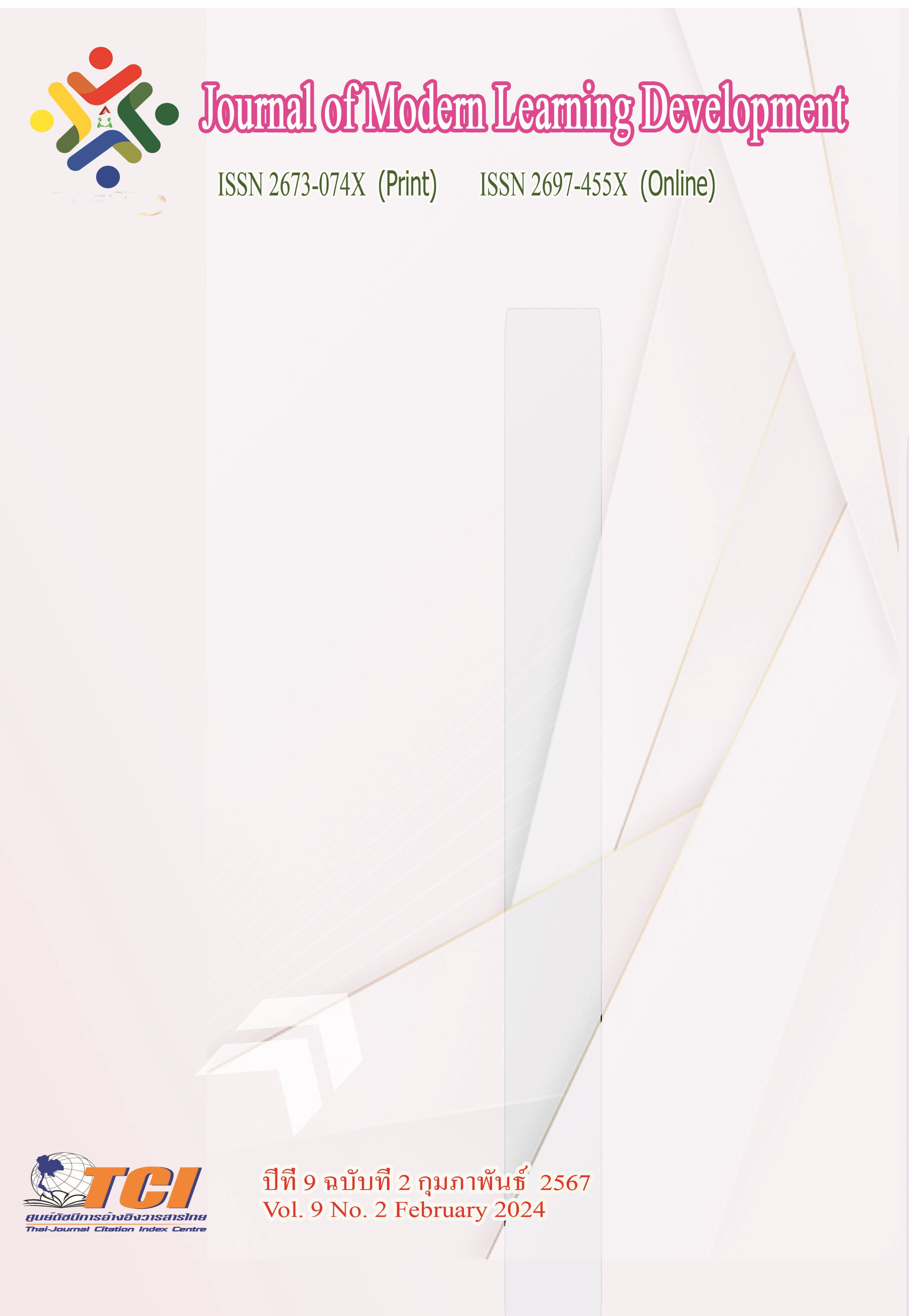In Spirit: Creation of Contemporary Instrumental Music
Main Article Content
Abstract
This research is creative work. The creator was inspired by memo “It was my desire to have my very own space” by Tang Chang. The purpose is to study 1) Create “In Spirit” as contemporary music. 2) Perform with the string combo. Study concepts and theories from literature and research. Collect data through expert interviews by interviews form on language interpretation, Thai music creation and international music creation.
The results showed that (1) The creative work has a total of 5 Section ABCAB, Time signature, Key signature E minor , G major, and F minor, Tempo 77 Bpm. The functioning of the melody is a melody that combines the stress of international and Thai original melodies. Using 7 chords and 9 11 13 extension chord. Introduction is on E natural minor scale, represents loneliness. Section A is on the G major scale, represents sensitive. Section B is on the F minor scale, represents power. Section C, the creator wishes to improvise By using the chords of Section A to convey the emotions of the performer. At the end of section C, repeat with section A and end with section B. (2) Creative work In Spirit: Creation of Contemporary Instrumental Music. The creator defined the style of the band that performs with string combo. Which includes drum set, electric bass guitar, electric guitar, piano, trumpet, trombone and tenor saxophone. The main melody is performed by electric guitar. In addition, instruments and music content can be adjusted accordingly.
Article Details
References
กัณหรัตน์ เหลื่อมเจริญ. (2550). กระบวนการสร้างสรรค์และนำดนตรีฃอง ดนู ฮันตระกูล มาใช้ในงานสื่อสารมวลชน. วิทยานิพนธ์นิเทศศาสตร์มหาบัณฑิต คณะนิเทศศาสตร์. บัณฑิตวิทยาลัย: จุฬาลงกรณ์มหาวิทยาลัย.
เขตต์อรัญ เลิศพิพัฒน์. (2545). คิดคำทำเพลง : ศิลปะการแต่งเนื้อเพลงไทย. กรุงเทพมหานคร: ชมรมคีตกวี.
ณรงค์ฤทธิ์ ธรรมบุตร. (2552). การประพันธ์เพลงร่วมสมัย. กรุงเทพมหานคร: สำนักพิมพ์แห่งจุฬาลงกรณ์มหาวิทยาลัย.
ดุษฎี มีป้อม และ นิลวรรณ ถมังรักษ์สัตว์. (ไม่แสดงปี). ดนตรี-นาฏศิลป์. กรุงเทพมหานคร: สำนักพิมพ์วัฒนาพานิช.
นวภู แซ่ตั้ง. (2562). จ่าง แซ่ตั้ง กับ โลกศิลปะก่อนและหลัง 14 ตุลาฯ 16. วารสารสังคมศาสตร์ มหาวิทยาลัยนเรศวร. 15 (2), 114.
ไพรัช มากกาญจนกุล. (2531). หลักการแต่งเพลง (พิมพ์ครั้งที่ 2). กรุงเทพมหานคร: หรรษา ผู้จัดจำหน่าย.
ภูเขา บนสายธาร. (2555). 22 ปี มรณกาล จ่าง แซ่ตั้ง "เพราะฉันต้องการที่ว่างของฉัน". ออนไลน์. สืบค้นเมื่อ 4 ธันวาคม 2565. แหล่งที่มา: https://prachatai.com/journal/2012/09/42464
มโน พิสุทธิรัตนานนท์. (2546). สุนทรียศาสตร์เบื้องต้น. สงขลา: มหาวิทยาลัยทักษิณ.
รณชัย รัตนเศรษฐ. (2546). วิเคราะห์การเรียบเรียงเสียงประสาน เพลงเสี่ยงเทียน สำหรับวงดุริยางค์ ซิมโฟนี ของครูประสิทธิ์ ศิลปะบรรเลง. ปริญญานิพนธ์ศิลปกรรมศาสตร์มหาบัณฑิต คณะศิลปกรรมศาสตร์. บัณฑิตวิทยาลัย: มหาวิทยาลัยศรีนครินทรวิโรฒ.
อมรรัตน์ ทิพเลิศ. (2545). มิวสิควิดีโอ : เต็มใจจะเจ็บ ไม่เคยเข็ดในรัก. สื่อบันเทิง : อำนาจแห่งความไร้สาระ, ออล อเบ้าท์ พริ้นท์.


